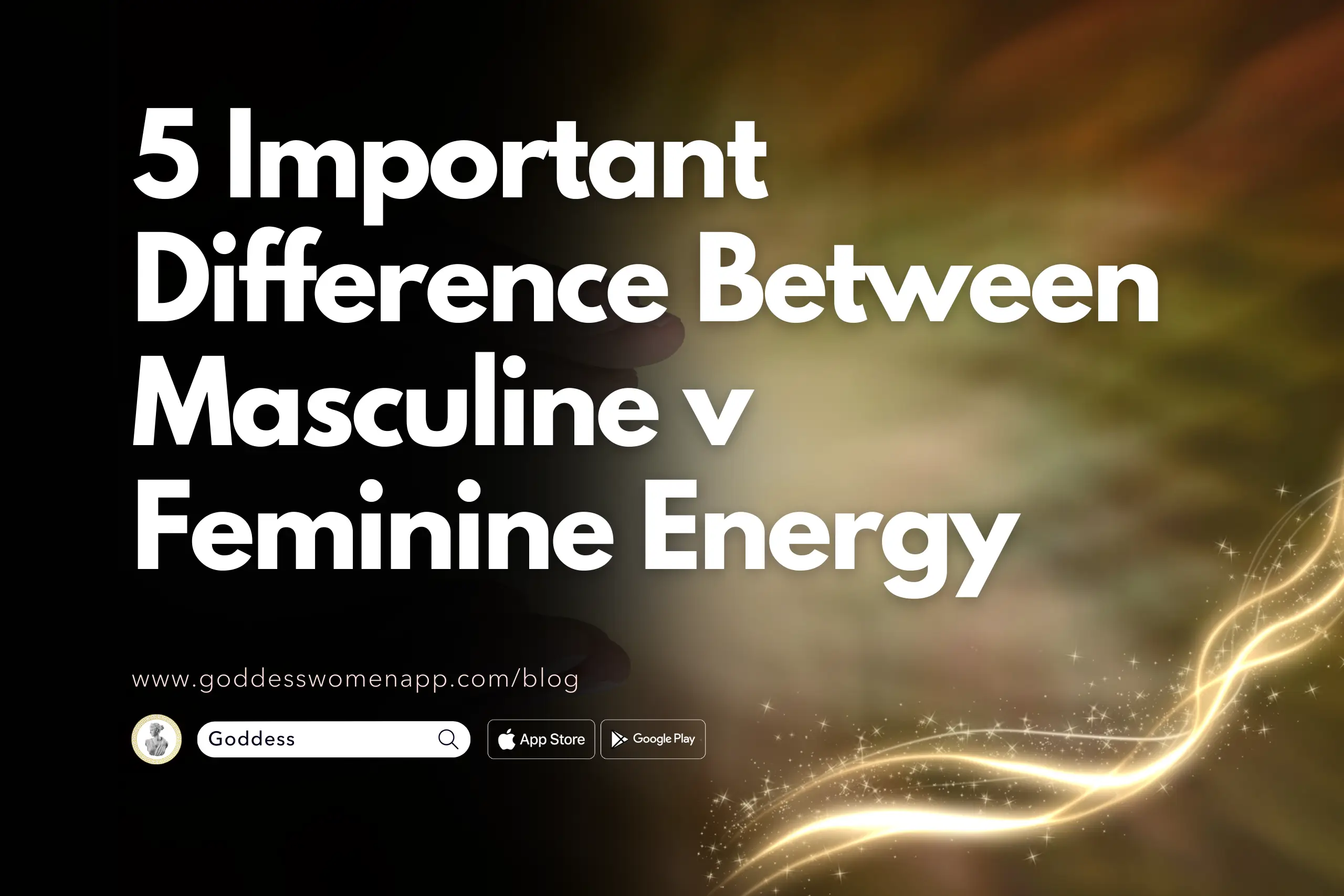Table of Contents
Introduction
In the vast expanse of human experience, the concepts of masculine and feminine energy play pivotal roles, transcending beyond mere gender identities to touch the very core of our behaviors, relationships, and personal growth. These energies, inherent in each of us, offer profound insights into our actions, decisions, and interactions with the world. Understanding the dynamic interplay between masculine and feminine energies can illuminate the path to balance, harmony, and deeper self-awareness. This guide delves into the 5 key differences between masculine and feminine energies, providing a comprehensive exploration aimed at fostering an environment of growth, understanding, and balance in our lives.
The Essence of Masculine v Feminine Energy
Before we dive into the distinctions, it’s crucial to grasp the essence of what we refer to as masculine and feminine energy. These terms transcend biological sex and societal gender roles, representing instead the dual qualities present in all of us, regardless of our gender identity.

Masculine Energy: Definition and Characteristics
Masculine energy is often characterized by action, assertiveness, and strength. It’s the driving force that propels us towards goal achievement, offering structure, stability, and logic. This energy is not confined to men; it’s a universal force that pertains to the outward, assertive, and analytical aspects of human nature. Attributes commonly associated with masculine energy include decisiveness, competitiveness, and the capacity for logical reasoning. In essence, it’s the part of us that seeks to protect, provide, and solve problems.
Feminine Energy: Definition and Characteristics
In contrast, feminine energy is associated with intuition, emotion, and nurturing. This energy is receptive, flexible, and relational, focusing on connection, empathy, and care. Feminine energy embodies the qualities of creativity, sensitivity, and emotional intelligence, facilitating healing, community, and personal relationships. Like its masculine counterpart, feminine energy is present in everyone and is not limited by gender. It represents the inner world of being, intuition, and the capacity for deep emotional connection.

Key Difference 1: Approach to Problem-Solving
One of the most striking distinctions between masculine v feminine energy lies in their approach to problem-solving. This difference not only affects personal and professional scenarios but also shapes the way individuals navigate challenges and conflicts.
Masculine Energy: Solution-Oriented
Masculine energy approaches problem-solving with a focus on finding immediate, logical solutions. It’s driven by the end goal, emphasizing efficiency, practicality, and direct action. Individuals channeling their masculine energy tend to dissect problems, breaking them down into manageable parts to tackle systematically. This method is highly effective in situations requiring quick decision-making and clear, concise action plans. However, it might sometimes overlook the emotional aspects or the deeper underlying causes of a problem.
Feminine Energy: Process-Oriented
Conversely, feminine energy adopts a more process-oriented approach to problem-solving. It values the journey of understanding the issue, emphasizing emotional intelligence, intuition, and holistic consideration. This energy seeks to explore the root causes of problems, focusing on relational dynamics and emotional impacts. By valuing the process as much as the outcome, feminine energy fosters a nurturing environment where solutions are developed through empathy, collaboration, and understanding. This approach shines in scenarios requiring deep emotional insight and long-term relationship building but might be perceived as less efficient in situations demanding immediate results.
Key Difference 2: Communication Styles
The manner in which masculine and feminine energies communicate represents another fundamental difference, influencing interpersonal relationships, workplace dynamics, and self-expression.
Masculine Energy: Direct and Assertive
Masculine energy in communication is characterized by directness and assertiveness. It values clarity, brevity, and getting straight to the point, often prioritizing facts over feelings. This style is effective in scenarios where decisions need to be made quickly and instructions need to be clear and unambiguous. However, it can sometimes be perceived as blunt or insensitive, especially in emotionally charged situations.
Feminine Energy: Empathetic and Relational
Feminine energy, on the other hand, emphasizes empathy, connection, and relational communication. It involves listening actively, expressing oneself with consideration for the other’s feelings, and prioritizing the maintenance of relationships over the mere conveyance of information. This style excels in creating an inclusive atmosphere, fostering deeper understanding and emotional bonds. While highly effective in building rapport and consensus, it may sometimes be seen as indirect or overly concerned with emotions in contexts where brevity and decisiveness are called for.

Key Difference 3: Relationship to Emotions
The relationship to emotions varies significantly between masculine and feminine energies, influencing how individuals process feelings, respond to emotional situations, and connect with others on an emotional level.
Masculine Energy: Reserved Emotional Expression
Masculine energy tends to prioritize logic and rationality over emotional expression. It often manifests as a more reserved or controlled approach to emotions, where individuals may seek to understand and manage their feelings internally before expressing them outwardly. This can lead to a perception of strength and stability, as emotions are not immediately visible on the surface. However, it can also result in difficulties in communicating emotional needs or empathizing with others, potentially leading to misunderstandings or a sense of emotional detachment.
Feminine Energy: Open and Expressive
Feminine energy embraces emotions as a natural and integral part of the human experience. It encourages open expression and sharing of feelings, fostering an environment where emotional vulnerability is seen as a strength rather than a weakness. This approach allows for deeper emotional connections and understanding, as individuals feel safe to express their emotions freely. While this can greatly enhance personal relationships and self-awareness, it may sometimes be overwhelming or seen as overly sensitive in contexts that demand a more stoic or reserved emotional response.

Key Difference 4: Decision-Making Processes
The process of making decisions also highlights a distinct difference between masculine and feminine energies, reflecting in the way choices are approached, analyzed, and ultimately made.
Masculine Energy: Logic and Analysis-Based
Masculine energy approaches decision-making with a focus on logic, analysis, and objective criteria. Decisions are often made by weighing the pros and cons, considering the practical implications, and aiming for the most efficient and effective outcome. This methodical approach is valuable in situations requiring clear, decisive action and when outcomes can be logically predicted or measured. However, it may overlook the nuanced emotional or relational aspects that could be crucial to the decision’s long-term success or personal satisfaction.
Feminine Energy: Intuition and Feeling-Based
In contrast, feminine energy relies heavily on intuition and feelings in the decision-making process. Decisions are made by tuning into one’s inner sense of knowing, considering how choices resonate emotionally, and how they impact relationships and personal well-being. This approach allows for a holistic consideration of options, where not only the logical outcomes but also the emotional and relational dimensions are valued. While this can lead to more satisfying and harmonious decisions on a personal level, it may be challenging in environments where decisions are expected to be justified through objective analysis or where immediate clarity is required.

Key Difference 5: Approach to Leadership and Authority
The distinction between masculine and feminine energies extends into the realm of leadership and authority, with each energy bringing unique strengths and perspectives to leadership roles and organizational dynamics.
Masculine Energy: Hierarchical and Goal-Oriented
Masculine energy in leadership is often characterized by a hierarchical and goal-oriented approach. Leaders channeling masculine energy tend to focus on structure, objectives, and clear outcomes. They are decisive, often employing a top-down leadership style that emphasizes control and direction. This approach is highly effective in situations requiring quick decision-making, clear directives, and when the goal is to achieve specific, measurable outcomes. However, it can sometimes lead to a rigid work environment, where innovation and emotional well-being are secondary to productivity and results.
Feminine Energy: Collaborative and Process-Oriented
Feminine energy brings a collaborative and process-oriented approach to leadership. Leaders embodying this energy prioritize relationships, team cohesion, and a participatory decision-making process. They are more likely to employ a democratic or transformational leadership style, valuing empathy, understanding, and the collective well-being. This approach fosters an inclusive and supportive work environment, encouraging creativity, personal growth, and mutual respect. While this can significantly enhance team dynamics and innovation, it may face challenges in situations where quick, unilateral decisions are necessary.
Conclusion
The exploration of the 5 key differences between masculine and feminine energies reveals the profound impact these energies have on our problem-solving strategies, communication styles, emotional relationships, decision-making processes, and leadership approaches. Recognizing and valuing these differences is crucial for personal development, interpersonal relationships, and professional success.
Embracing both masculine and feminine energies within ourselves leads to a more balanced, fulfilled, and harmonious existence. It allows us to navigate life’s challenges with a comprehensive toolkit, drawing on the strengths of both energies as needed. In a world that increasingly recognizes the value of diversity and balance, understanding the interplay between masculine and feminine energies is more important than ever.
This guide invites readers to reflect on their own energies, encouraging a journey towards balance and integration. By acknowledging the unique contributions of both masculine and feminine energies, we can aspire to lead lives that are not only productive and goal-oriented but also nurturing, empathetic, and deeply connected.
In the dance of life, let us learn to move gracefully between the assertive push of masculine energy and the receptive flow of feminine energy, creating a symphony of balance that enriches every aspect of our lives.





